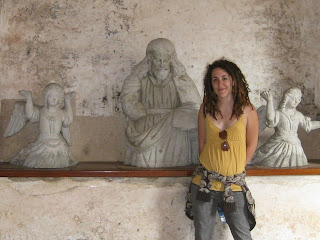As Guatemala’s foremost colonial jewels and a declared world heritage site, there is too much to write about Antigua. I visited it for the first time (but not the last) with my daughter on March 14-15, 2009. Antigua was actually Guatemala's third capital, but due to relentless natural disasters (mudslide in 1541; earthquake in 1717), much of population abandoned Antigua after two severe tremors in 1773. The city's history is so rich and dense that I will leave it to readers to do their own research. I will only report what my daughter and I experienced during our first visit here.
When we arrived with a shuttle from Pana, we were delivered at a delightful hotel Uxlabil, which my friend and tour operator Helmuth (friend of Julie Yindra, a colleague at Greensboro College) arranged for us. What a great find (and so was the guide Helmuth organized for us the following day)! Uxlabil is a historical building with its own museum which we failed to visit. However, when Helmuth warned Lorca to watch out for the spirits that haunted the hotel, I thought it better that we did not probe into its history. Lorca was spooked enough.
The interior of Hotel Uxlabil
One of the employees
Lorca and I spent Saturday afternoon checking out shops. One in particular Nim Po't, recommended by Helmuth, was outstanding in its array of Maya woven bags, clothing, costumes as well as other quality handicrafts from Guatemala. One could not bargain in this store (like most in Antigua) but the prices were very fair.
(this arch served as a passageway
for nuns to cross the street without being seen)
 The arch from another viewpoint.
The arch from another viewpoint.Notice the purple drapery on the balcony.
This signifies the approaching of Holy Week.
It was a scene out of one of those cross-cultural romantic dance films. We were lucky enough to land a table very close to the band before the place filled up and spilled over with patrons. It was standing room only after 10:30. What was fascinating about the club was the demographics. There were mostly Guatemalan men and gringa women! The Guatemalan men were, for the most part, polished salsa dancers and the gringa women amateurs who were however very eager to have free dancing lessons. There was one triad of Guatemalan dancers, two men and a woman, who could have easily been type-casted as Latin Hollywood actors. They were beautiful, sexy, extremely suave and talented on the dance floor. The one tall very attractive Guatemalan (Antonio Banderas's look-alike) asked an equally good-looking American woman to dance with him. It became obvious that she had had a lot of experience dancing (she even did a split) and the two made a ravishing couple to goggle at. He still had the upper hand on the moves and from her body language, he was teaching her steps she didn't know. The fascinating aspect of watching them is that he would do some very erotic dance movements with her which she complied with but from her facial expression, one could tell she was embarrassed and yet thrilled by her teacher's forwardness.
Lorca had had a little experience with salsa dancing. She was asked by two Guatemalan men to dance. According to Lorca, the first dancer was terrible; the second, however, knew his stuff. He wiggled, swayed, and twirled her around at alternatively languid and frenzied paces. I was impressed with Lorca's adaptability and gracefulness. She appeared to be a natural. She told me later that she attributes this to her Spanish side of the family.
The next day we toured the sites of Antigua. Our guide impressed us with his breadth of knowledge which included a long memorized list of dates. He spoke to us in Spanish, but he could give the same tour in English: he was totally self-taught. He spent over three hours with us, guiding us through majestic churches and convents as well as gorgeous, decadent hotels and restaurants.
Risque central fountain at the Parque Central
The central plaza used to host a bustling market,
bullfights, military parades, floggings, and public hangings.
Cathedral de San Jose at Parque Central, illuminated at night
One site in particular was the famous La Merced whose facade is indeed grandiose. Again, it attests to the blending of Catholic and Maya belief systems since, if you look closely at the moulding in the front, there are sculpted corn cobs which symbolize the Maya belief that mankind came from corn. Inside, there were pre-holy week preparations. On the floor there were drawings of religious imagery made from painstakingly hand-strewn colored sawdust. Maya worshippers had also laid offerings of home-grown vegetables on the borders of these remarkable floor paintings. One is reminded of the Buddhist sand paintings which are eventually destroyed.
LaMerced
Exquisite floor painting out of colored sawdust
Close-up of sawdust floor painting
One of the trivia that our guide passed on to us is that in other to preserve its historical heritage, building codes in Antigua are very strict. If businesses and homeowners wish to paint the facades of their building, they are restricted to eight colors: variations of blue, red, yellow, and green. They are also not permitted to build extensions.
Calle de los Nazarenos, a typical street in Antigua
Antigua is indeed one of Guatemala's historical, architectural gems. I look forward to learning more about this city during visits with friends in the near future.
Now it is being renovated into a museum.













No hay comentarios:
Publicar un comentario